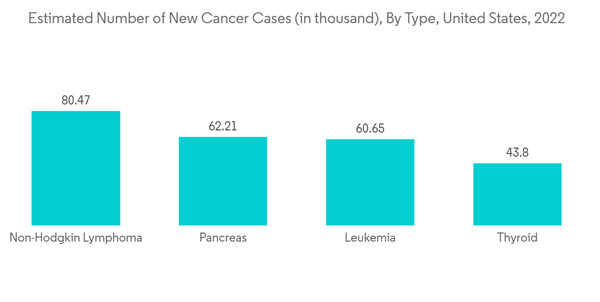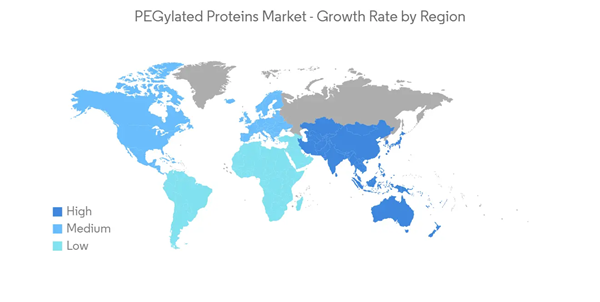The impact of COVID-19 on the PEGylated proteins market was moderate. According to the study published in Biomaterial in June 2021, PEGylated nanoparticle albumin-bound (PNAB) -steroidal ginsenoside can effectively lower histone H4 and NETosis-related factors in the plasma and ameliorate SREBP2-mediated systemic inflammation in SARS-CoV-2 ICU patients. PNAB-steroidal ginsenoside medications may be useful in treating symptoms associated with severe SARS-CoV-2 patients, such as coagulation and cytokine storm. Furthermore, according to an article published by PubMed Central in August 2021, a phase III clinical trial showed the efficacy and safety of pegylated interferon alpha-2b (PEG IFN-α2b) in patients with moderate COVID-19 infections. Thus, given the extensive research activities based on PEGylation technology, the COVID-19 pandemic impacted the market moderately; however, as the pandemic has subsided currently, the studied market is expected to have stable growth during the forecast period of the study.
The major factor attributing to the growth of the market is the increasing prevalence of chronic diseases like cancer, kidney diseases, and rheumatoid arthritis. According to the data from the American Cancer Society 2022, an estimated 1,908,030 new cancer cases are expected to be diagnosed in the United States in 2022. Moreover, as per the same source, among all cancers, digestive system cancer is expected to account for 343,040 cases, breast cancer is expected to account for 290,560 new cancer cases, followed by respiratory system cancer, with 254,850 new cases in 2022. Additionally, as per the Global HIV and AIDS Statistics, 2022 fact sheet by UNAIDS, 38.4 million people globally were living with HIV in 2021. Thus, with the growing burden of chronic and infectious diseases such as cancer, HIV, tuberculosis, and others globally, the demand for developing medicine is also expected to increase, which will boost the research on protein, thus driving the PEGylated protein market.
Furthermore, biotechnology and pharmaceutical companies' growing investments in research and development programs are boosting the market growth. For instance, in March 2022, Flow Eighteen38, a protein sciences division created to facilitate and accelerate antibody characterization and protein purification projects, announced a EUR 5 million (USD 5.58 million) investment into its protein production and biophysical characterization capabilities and services from its parent company, CRO FairJourneyBiologics S.A. In addition, there is rising adoption of protein-based drugs over non-protein-based drugs wherein PEGylation increases the circulation and half-life of the proteins, improving the efficacy.
Therefore, the factors above, such as the growing burden of chronic and infectious diseases such as cancer, HIV, tuberculosis, and others globally, and the growing investments in research and development programs by biotechnology and pharmaceutical companies, the market is expected to experience growth. However, the high drug failure rates and drug recalls are the major factors impeding the market's growth.
PEGylated Proteins Market Trends
The Colony-stimulating Factors Segment is Expected to Grow at a Significant Rate Over the Forecast Period
Colony-stimulating factors are substances that accelerate the production of blood cells and elevate their ability to function. They do not directly influence tumors but have a role in stimulating blood cells, and hence, these factors can be beneficial in supporting a person's immune system during cancer treatment.According to the research article published in Frontier in Oncology in April 2022, a half-dose of prophylactic granulocyte-colony stimulating factor (G-CSF) can effectively and safely prevent neutropenia in patients with various malignancies who have an intermediate risk of febrile neutropenia (FN) combined with 1 patient-specific risk during chemotherapy. Thus, the above benefits of the colony-stimulating factors in the treatment of tumors are expected to boost segment growth.
Furthermore, the market growth of the segment is due to the increasing incidence of cancer across the globe, and the usage of peptide treatment for cancer. According to the data published by National Cancer Center Japan in June 2022, an estimated 1,019,000 new cases of cancer are expected in Japan in 2022, out of which 158,200 new cases of colon/rectum cancer, 132,100 cases of stomach cancer, 128,800 cases of lung/trachea cancer, 96,400 cases of prostate cancer, and 95,000 cases of breast cancer are expected. Furthermore, according to an article published by NCBI in March 2022, China is experiencing a greater incidence of cancers. In 2022 it is expected that there will be approximately 4,820,000 new cancer cases in China, in which the most common is lung cancer. Thus, the high incidence of cancer surges the need for colony-stimulating factors in its effective treatment and thus drives segment growth.
Furthermore, the increased awareness among patients and healthcare professionals regarding the adverse effects of other methods of cancer treatments, such as chemotherapy and radiation therapy, is a major factor for the growing focus on alternative therapeutics such as pegylated peptide-based drugs. Hence, the aforementioned factors are expected to positively drive the growth of the colony-stimulating factors segment over the forecast period.
North America Holds a Significant Share of the Market and is Expected to do the Same Over the Forecast Period
North America is expected to hold a significant share of the overall PEGylated protein market throughout the forecast period. The presence of key players, the high prevalence of chronic diseases in the region, established healthcare infrastructure, and growing awareness of advanced treatment options among the American population are some of the key factors accountable for its large share in the market. In November 2022, the Canadian Cancer Society data stated, it was estimated that 233,900 people will be diagnosed with cancer in 2022, and this growth in incidence is largely due to Canada’s growing and aging population. Thus, the growing prevalence of chronic diseases is expected to rise in research and development activity driving the growth of the market in the region over the forecast period.Furthermore, the rising geriatric population and the high incidence of chronic diseases are also expected to play a vital role in the growth of the studied market. According to the estimates of the American Cancer Society, in 2022, it was expected that 79,000 new instances of kidney cancer are likely to be diagnosed in the United States in 2022, including 50,290 cases in males and 28,710 cases in women. The top 10 malignancies for both men and women include kidney cancer. Men have about a 1 in 46-lifetime risk of having kidney cancer (2.02%). For women, the lifetime risk is approximately 1 in 80. (1.03%). Thus, the growing prevalence of chronic diseases in the region is likely to propel the growth of the market.
Furthermore, beneficial government initiatives and an increase in the number of research partnerships are some of the factors expected to drive market growth. For instance, in February 2021, Nautilus merged with Arya III, a special purpose acquisition company (SPAC), with an initial investment of USD 350 million to ramp up work developing its protein analysis technology for drug discovery and diagnostic applications.
Hence, due to the aforementioned factors such as the increasing prevalence of chronic diseases in the region and beneficial government initiatives and an increase in the number of research partnerships, are expected to boost the market growth in the region.
PEGylated Proteins Market Competitor Analysis
The PEGylated proteins market is moderately consolidated and consists of a few major players. Some companies currently dominating the market are Merck KGaA, Thermo Fisher Scientific Inc., NOF America Corporation, JenKem Technology USA Inc., Creative PEGworks, and Celares GmbH, among others. The companies have been following various strategies such as acquisitions, partnerships, investments in research activities, and new product launches to sustain themselves among the competitors in the global market.Additional benefits of purchasing the report:
- The market estimate (ME) sheet in Excel format
- 3 months of analyst support
This product will be delivered within 2 business days.
Table of Contents
Companies Mentioned (Partial List)
A selection of companies mentioned in this report includes, but is not limited to:
- Merck KGaA
- Thermo Fisher Scientific Inc.
- NOF America Corporation
- JenKem Technology USA Inc.
- Creative PEGworks
- Celares GmbH
- Quanta BioDesign Ltd
- Biogen Inc.
- F. Hoffmann-La Roche Ltd
- Horizon Pharma PLC
- Pfizer Inc.
- Takeda Pharmaceuticals U.S.A., Inc.(Shire PLC)
- Quiapeg Pharmaceuticals Holding AB










